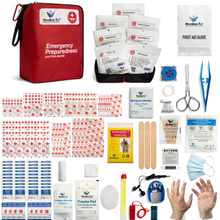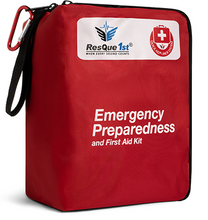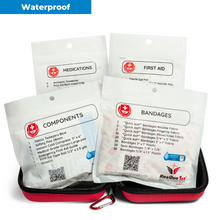
Getting outside and experiencing our wonderful land is always a joy. But danger is never far away. Whether you’re hiking, backpacking, camping, hunting, hitting the beach or even picnicking, something can go wrong while you’re out and about. Trips and falls, cuts, sticker bushes, bug bites, burns and breaks can all intrude on the experience. The last thing you want is to be both hurt and stranded. Therefore, a portable outdoor safety kit is more than a good idea – it’s a must. You’ll need essential tools, some food, emergency items and, of course, a first aid kit.
Portability
The first thing you need to consider for your outdoor safety kit is how you’ll carry it. Start with the first aid kit – that’s an obvious priority – and build from there. Even at this first step, you’re presented with plenty of choices. A humongous first aid kit like they have in parks, zoos, theme parks and EMT vehicles take up more than a backpacks or duffel bag. Pocket kits seem cool at first, but many include barely enough supplies for a splinter. Finding a happy medium between contents and size is the goal. Fitting a first aid kit into a backpack with room to spare is ideal. It doesn’t matter if you’re alone or in a group, choose one that’s light, portable, but also helpful.
Don’t Overstuff
Your outdoor safety kit doesn’t have to be a bugout bag for the apocalypse. Overfilling just makes it heavier. It also makes finding what you need more difficult. Analyze your situation logically. If you’re going for a casual daytime nature hike at your local national park, then you most likely won’t need a tent or cooking supplies let alone water purification tablets, burn gel, and the like. Pack for your immediate need and then add for an extra day or two.
First Aid and Emergency Kit Combined
Your outdoor safety kit needs a well-stocked first aid kit and some helpful survival items. Your best bet is to buy an ANSI-certified emergency preparedness kit that’s carried inside a lightweight, zip up, waterproof cover. It should include items like:
- Band-Aids and small adhesive dressings in various sizes
- assorted bandages and gauze
- antiseptic towelettes, alcohol wipes and insect sting treatments
- medical tape
- scissors
- painkillers
- cold pack
- emergency blanket and poncho
- radio and batteries
- light stick
- and so on.
Such a kit will have what you need to administer first aid and handle the elements for a few days until professional assistance arrives or is found.
Trauma Supplies
Serious accidents can happen when you’re in the great outdoors. So many people have suffered or died because they didn’t have a few extra essentials. It takes very little effort to beef up your outdoor safety kit by adding a lightweight portable trauma kit. This would contain specially treated clotting sponges for heavier bleeding, tourniquets, gloves, and a small CPR mask.
Tools of the Trade
The Boy Scouts are right: be prepared. If you’re heading out for a few days, either by yourself or in a group, a few tools and handy items won’t take up huge space or add massive weight to your outdoor safety kit:
- Bug spray.
- A good multi-tool that includes a folding saw.
- Flashlight.
- Firestarters.
- Waterproof matches.
- String.
- Trail mix and energy bars.
- Carabiners.
- Duct tape.
- A can – great for storing items and also for collecting and boiling water.
These are the kinds of items that won’t overstuff your kit. Avoid adding ‘luxury’ items to it.
If you follow all the advice here, you will have a very useful outdoor safety kit that will serve you well and not be a hassle to carry. Just be sure you buy the best first aid supplies and always tell people where you’re headed and when you’re expected back again.
Be safe out there and enjoy!
Creative Commons Attribution: Permission is granted to repost this article in its entirety with credit to First Aid Shoppe and a clickable link back to this page.








